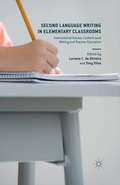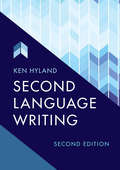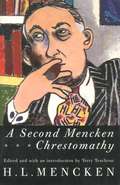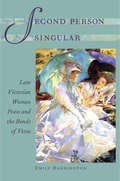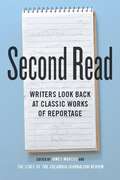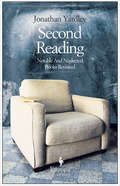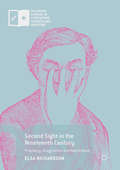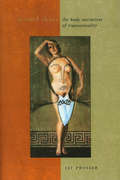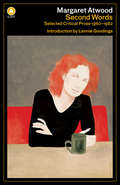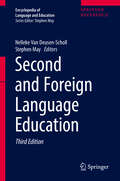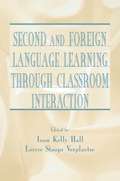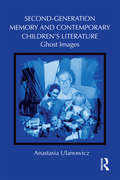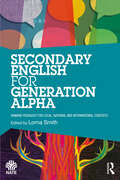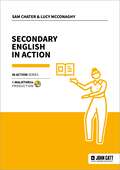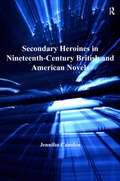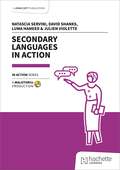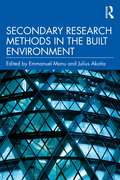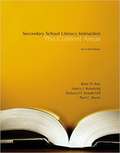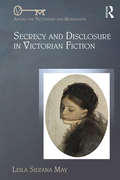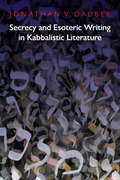- Table View
- List View
Second Language Writing in Elementary Classrooms: Instructional Issues, Content-area Writing and Teacher Education
by Luciana C. de OliveiraSecond Language Writing in Elementary Classrooms focuses on L2 writing in elementary classrooms. It features chapters that highlight research in elementary classrooms focused on the writing development of multilingual children, and research in teacher education to prepare elementary teachers to teach L2 writing and address L2 writers' needs.
Second Language Writing: Contexts And Issues (The\michigan Series On Teaching Multilingual Writers)
by Ken HylandAuthoritative and accessible, this book introduces the theory and practice of teaching writing to students of EFL/ESL learners. While assuming no specialist knowledge, Ken Hyland systematically sets out the key issues of course design, lesson planning, texts and materials, tasks, feedback and assessment and how current research can inform classroom practice. This second edition is completely revised to include up-to-date work on automated feedback, plagiarism, social media, Virtual Learning Environments and teacher workload issues. It takes the clear stance that student writers not only need realistic strategies for drafting and revising, but also a clear understanding of genre to structure their writing experiences according to the expectations of particular communities of readers and the constraints of particular contexts. Review exercises, reflection questions, plentiful examples and a new extensive glossary make the book invaluable to both prospective and practicing teachers alike.
Second Life as a Virtual Playground for Language Education: A Practical Guide for Teaching and Research
by Julian ChenThis insightful book offers language teachers and teachers in training the opportunity to delve into 3D virtual worlds and see the benefits they provide for effective language teaching. Based on a decade of experience teaching and researching in Second Life (SL), Chen demystifies the dos and don’ts of SL teaching and research, whilst vividly walking readers through each step of the journey. Written in an accessible, jargon-free, and personalised tone, the book is divided into three parts. Part I builds the foundation in SL research, task-based language teaching (TBLT), and understanding fundamental skills for SL teaching. Part II showcases the author’s SL teaching blog that generously unveils their task-based, SL-enabled lessons, participant observations, critical reflections, and lessons learned from each SL session. Part III is complete with the highlights of the author’s SL research and hands-on resources and tips for readers. Each chapter also features a "Checkpoint" section to gauge reader understanding of chapter content, followed by a "Your Task" section to promote learning by doing in SL. Teachers and curriculum designers will find the well-detailed and guided lesson planning useful when starting their first SL class. Graduate students and novice researchers will also find the systematically recorded data collection helpful for their SL research.
Second Mencken Chrestomathy
by H. L. Mencken"This Wonderful Sequel to the best-selling A Mencken Chrestomathy of nearly half a century ago is full of the iconoclastic common sense that marked H. L. Mencken's astonishing career as the premier American social critic of the twentieth century. Gathered by Mencken himself before he died in 1956, this second chrestomathy ("a collection of selected literary passages," with the accent on the tom) contains writings about a variety of subjects - politics, war, music, literature, men and women, lawyers, brethren of the cloth. Some of his essays have beguiling titles - "Notes for an Honest Autobiography," "The Commonwealth of Morons," "Le Vice Anglais," "Acres of Babble," "Hooch for the Artist. " All of them are a pleasure to read, and we are reminded that what Mencken wrote in the early years of this century remains applicable to a very different America. "--BOOK JACKET. Title Summary field provided by Blackwell North America, Inc. All Rights Reserved
Second Person Singular: Late Victorian Women Poets and the Bonds of Verse (Victorian Literature and Culture Series)
by Emily HarringtonEmily Harrington offers a new history of women's poetry at the turn of the century that breaks from conventional ideas of nineteenth-century lyric, which focus on individual subjectivity. She argues that women poets conceived of lyric as an intersubjective genre, one that seeks to establish relations between subjects rather than to constitute a subject in isolation. Moving away from canonical texts that contribute to the commonly held notion that lyric poetry is an utterance made in solitude, Harrington explores the work of Christina Rossetti, Augusta Webster, A. Mary F. Robinson, Alice Meynell, and Dollie Radford to show how nineteenth-century poetic conventions shaped and were shaped by concepts of intimacy. Writing about relationships that are familial, divine, sexual, literary, and musical, these poets reconsidered the dynamics of absence and presence, and subject and object, that are at the heart of the lyric enterprise.Harrington locates these poets' theories of intimacy not only in their formal poetic practice but also in diverse prose works such as prefaces, literary and devotional essays, and unpublished letters and diaries. By analyzing various patterns of versification and modes of address, she articulates new ways of thinking about the bonds of verse and enlarges our understanding of verse culture in the late nineteenth century.
Second Read: Writers Look Back at Classic Works of Reportage (Columbia Journalism Review Books)
by James MarcusThe Columbia Journalism Review's Second Read series features distinguished journalists revisiting key works of reportage. Launched in 2004 by John Palattella, who was then editor of the magazine's book section, the series also allows authors address such ongoing concerns as the conflict between narrative flair and accurate reporting, the legacy of New Journalism, the need for reporters to question their political assumptions, the limitations of participatory journalism, and the temptation to substitute "truthiness" for hard, challenging fact. Representing a wide range of views, Second Read embodies the diversity and dynamism of contemporary nonfiction while offering fresh perspectives on works by Norman Mailer, Tom Wolfe, Rachel Carson, and Gabriel García Márquez, among others. It also highlights pivotal moments and movements in journalism as well as the innovations of award-winning writers.Essays include Rick Perlstein on Paul Cowan's The Tribes of America; Nicholson Baker on Daniel Defoe's A Journal of the Plague Year; Dale Maharidge on James Agee's Let Us Now Praise Famous Men; Marla Cone on Rachel Carson's Silent Spring; Ben Yagoda on Walter Bernstein's Keep Your Head Down; Ted Conover on Stanley Booth's The True Adventures of the Rolling Stones; Jack Shafer on Tom Wolfe's The Electric Kool-Aid Acid Test; Connie Schultz on Michael Herr's Dispatches; Michael Shapiro on Cornelius Ryan's The Longest Day; Douglas McCollam on John McPhee's Annals of the Former World; Tom Piazza on Norman Mailer's Armies of the Night; Thomas Mallon on William Manchester's The Death of a President; Miles Corwin on Gabriel García Márquez's The Story of a Shipwrecked Sailor; David Ulin on Joan Didion's Slouching Toward Bethlehem; and Claire Dederer on Betty MacDonald's Anybody Can Do Anything.
Second Reading: Notable And Neglected Books Revisited
by Jonathan YardleyThis collection of 5 dozen pieces of literary criticism was published in the Washington Post between March 2003 and January 2010. It is a collection of Yardley's opinions of books that he believes are worthy of a second look. They scan the realms of fiction, biography and autobiography, memoirs, and history.
Second Sight in the Nineteenth Century: Prophecy, Imagination and Nationhood (Palgrave Studies in Literature, Science and Medicine)
by Elsa RichardsonThis book explores the phenomenon of second sight in nineteenth-century literature and culture. Second sight is a form of prophetic vision associated with the folklore of the Scottish Highlands and Islands. Described in Gaelic as the An-da-shealladh or 'the two sights', those in possession of this extraordinary power are said to foresee future events like the death of neighbour, the arrival of strangers into the community, the success or failure of a fishing trip. From the late seventeenth century onwards, rumours of this strange faculty attracted the attention of numerous scientists, travel writers, antiquarians, poets and artists. Focusing on the nineteenth century, this book examines second sight in relation to mesmerism and phrenology, modern spiritualism and anthropology, romance literature and folklorism and finally, psychical research and Celtic mysticism. Tracing the migration of a supposedly 'Scottish' tradition through various sites of nineteenth-century popular culture, it explores questions of nationhood and identity alongside those posed by supernatural phenomena.
Second Skins: The Body Narratives of Transsexuality (Gender and Culture Series)
by Jay ProsserDo we need bodies for sex? Is gender in the head or in the body? In Second Skins Jay Prosser reveals the powerful drive that leads men and women literally to shed their skins and--in flesh and head--to cross the boundary of sex. Telling their story is not merely an act that comes after the fact, it's a force of its own that makes it impossible to forget that stories of identity inhabit autobiographical bodies.In this stunning first extensive study of transsexual autobiography, Jay Prosser examines the exchanges between body and narrative that constitute the phenomenon of transsexuality. Showing how transsexuality's somatic transitions are spurred and enabled by the formal transitions of narrative, Prosser uncovers a narrative tradition for transsexual bodies. Sex change is a plot--and thus appropriately transsexuals make for adept and absorbing authors. In reading the transssexual plot through transsexuals' own recounting, Prosser not only gives us a new and more accurate rendition of transsexuality. His book suggests transsexuality, with its extraordinary conjunctions of body and narrative, as an identity story that transitions across the body/language divide that currently stalls poststucturalist thought.The form and approach of Second Skins works to cross other important and parallel divides. In addition toanalyzing transsexual textual accounts, the book includes some 30 photographic portraits of transsexuals--poignant attempts by transsexuals to present themselves unmediated to the world except by the camera. And the author does not shy from exposure himself. Interjecting the personal into his theoretical discussion and close textual work throughout the book, Prosser reads and writes his own body, his purpose in that stylistic crossing to stake out transsexuality--and hence this very book--as his own body's narrative.
Second Words: Selected Critical Prose 1960–1982 (A List)
by Margaret AtwoodReissued in a handsome A List edition, the largest collection of critical prose to date from world renowned author and poet Margaret Atwood, featuring an introduction by Lennie Goodings.Originally published in 1982, Second Words brings together fifty of Margaret Atwood’s finest essays and reviews spanning two decades, beginning in 1962, with an introduction and commentary by the author. With her incomparable wit and originality, Atwood discusses the process of writing and the literary life, with insightful looks at the work of such figures as Erica Jong, E. L. Doctorow, Northrop Frye, Roch Carrier, Marie-Claire Blais, Gwendolyn MacEwen, Marge Piercy, Adrienne Rich, Sylvia Plath, and many more. In several pieces, we see the development of her ideas on Canadian identity and the American dream, as well as her controversial attitudes toward feminism, sexism, and the strange mythologies imposed on men and women in contemporary North America.Second Words remains the largest collection of Atwood’s critical prose to date.
Second Year Latin
by Robert J. HenleThe backbone of Henle Latin Second Year is intensive language study, including review of the first year plus new materials. Separated into four parts, Henle Latin Second Year includes readings from Caesar's Commentaries, extensive exercises, and Latin-English vocabularies. Humanistic insight and linguistic training are the goals of the Henle Latin Series from Loyola Press, an integrated four-year Latin course. Time-tested and teacher endorsed, this comprehensive program is designed to lead the student systematcially through the fundamentals of the language itself and on to an appreciation of selected classic texts.
Second and Foreign Language Education
by Stephen May Nelleke Van Deusen-SchollIn this third, fully revised edition, the 10 volume Encyclopedia of Language and Education offers the newest developments, including an entirely new volume of research and scholarly content, essential to the field of language teaching and learning in the age of globalization. In the selection of topics and contributors, the Encyclopedia reflects the depth of disciplinary knowledge, breadth of interdisciplinary perspective, and diversity of socio-geographic experience in the language and education field. Throughout, there is an inclusion of contributions from non-English speaking and non-western parts of the world, providing truly global coverage. Furthermore, the authors have sought to integrate these voices fully into the whole, rather than as special cases or international perspectives in separate sections. The Encyclopedia is a necessary reference set for every university and college library in the world that serves a faculty or school of education, as well as being highly relevant to the fields of applied and socio-linguistics. The publication of this work charts the further deepening and broadening of the field of language and education since the publication of the first edition of the Encyclopedia in 1997 and the second edition in 2008.
Second and Foreign Language Learning Through Classroom Interaction
by Joan Kelly Hall Lorrie Stoops VerplaetseThis volume brings together the current theoretical interest in reconceptualizing second and foreign language learning from a sociocultural perspective on language and learning, with practical concerns about second and foreign language pedagogy. It presents a set of studies whose focus is on the empirical description of particular practices constructed in classroom interaction that promote the learning of a second or foreign language. The authors examine in detail the processes by which the learning of additional languages is accomplished in the interaction of a variety of classrooms and in a variety of languages. Not only will the findings from the studies reported in this volume help to lay a foundation for the development of a more expansive, sociocultural model of second and foreign language learning, but on a more practical level they will help language educators in creating a set of principles for identifying and sustaining classroom interactional practices that foster additional language development. The volume is distinguished in three ways: * Following a Vygotskyan perspective on development, the studies assume that language learning is a fundamentally pragmatic enterprise, intrinsically linked to language use. This breaks from a more traditional understanding of second and foreign language learning, which has viewed learning and use as two distinct phenomena. The importance of classroom interaction to additional language development is foregrounded. * The investigations reported in this book are distinguished by their methodological approach. Because language learning is assumed to be a situated, context-sensitive, and dynamic process, the studies do not rely on traditional experimental methods for collecting and analyzing data, but rather, they involve primarily the use of ethnographic and discourse analytic methods. * The studies focus on interactional practices that promote second and foreign language learning. Although a great deal of research has examined first language learning in classrooms from a sociocultural perspective, little has looked at second and foreign language classrooms from such a perspective. Thus there is a strong need for this volume of studies addressing this area of research. Researchers, teacher educators, and graduate students across the fields of second and foreign language learning, applied linguistics, and language education will find this book informative and relevant. Because of the programmatic implications arising from the studies, it will also appeal to teacher educators and teachers of second and foreign languages from the elementary to the university levels.
Second-Generation Memory and Contemporary Children's Literature: Ghost Images (Children's Literature and Culture)
by Anastasia UlanowiczWinner of the Children’s Literature Association Book Award This book visits a range of textual forms including diary, novel, and picturebook to explore the relationship between second-generation memory and contemporary children’s literature. Ulanowicz argues that second-generation memory — informed by intimate family relationships, textual mediation, and technology — is characterized by vicarious, rather than direct, experience of the past. As such, children’s literature is particularly well-suited to the representation of second-generation memory, insofar as children’s fiction is particularly invested in the transmission and reproduction of cultural memory, and its form promotes the formation of various complex intergenerational relationships. Further, children’s books that depict second-generation memory have the potential to challenge conventional Western notions of selfhood and ethics. This study shows how novels such as Lois Lowry’s The Giver (1993) and Judy Blume’s Starring Sally J Freedman as Herself (1977) — both of which feature protagonists who adapt their elders’ memories into their own mnemonic repertoires — implicitly reject Cartesian notions of the unified subject in favor of a view of identity as always-already social, relational, and dynamic in character. This book not only questions how and why second-generation memory is represented in books for young people, but whether such representations of memory might be considered 'radical' or 'conservative'. Together, these analyses address a topic that has not been explored fully within the fields of children’s literature, trauma and memory studies, and Holocaust studies.
Secondary English for Generation Alpha: Humane Pedagogy for Local, National and International Contexts (National Association for the Teaching of English (NATE))
by Lorna SmithSecondary English for Generation Alpha seeks to promote a humane, responsive and creative pedagogy for English that will develop and enrich understanding and enjoyment of language in all its forms (speaking, listening, reading and writing) and help students develop into successful members of their home and wider communities.Generation Alpha (children born between 2010 and 2025) are growing up amid unprecedented challenges – local, national and global – that threaten social justice. The authors of this book see subject English as one means of supporting Generation Alpha to meet these challenges and provide them with the necessary skills and knowledge to fit them for a changing world. Responding to tendencies to standardise and centralise curriculum, pedagogy and teacher education, the book explores the ways in which subject English can draw on local contexts and expertise in schools, universities and communities to address local needs and interests, demonstrating how what we learn locally can be relevant beyond.The chapters in this volume represent work being done, individually and collectively, in settings across England, by teacher educators in universities and other centres, alongside their partnership schools. By describing their own practice in English classrooms, the authors hope to empower others – in England, but also beyond – simultaneously producing both a broad and an in-depth exploration of the subject. Secondary English for Generation Alpha emerges from the world of initial teacher education, yet takes ideas from current research and makes them relevant to teachers and those interested in English teaching in schools in any context.
Secondary English in Action
by Sam Chater Lucy McConaghyWith more than 20 years teaching experience between them, the authors of Secondary English in Action share clear examples of a range of strategies for teachers of secondary English, summarising research and thinking on approaches within English teaching while maintaining a focus on application in the classroom to inspire enthusiasm and love for English.Not bounded by the constraints of current examination frameworks but a vision of what experiencing English should be for a student, this book covers teaching students how to use oracy appropriately, how to interpret texts fully and how to create their own texts accurately and with purpose.McConaghy and Chater make the case for the importance and value of English, along with a range of ways to promote engagement and uptake and so, whether you are beginning your journey into teacher training, working as a teaching assistant or are an experienced teacher looking for new inspiration and ideas, this is an essential guide for all English classroom-based staff.
Secondary English in Action
by Sam Chater Lucy McConaghyWith more than 20 years teaching experience between them, the authors of Secondary English in Action share clear examples of a range of strategies for teachers of secondary English, summarising research and thinking on approaches within English teaching while maintaining a focus on application in the classroom to inspire enthusiasm and love for English.Not bounded by the constraints of current examination frameworks but a vision of what experiencing English should be for a student, this book covers teaching students how to use oracy appropriately, how to interpret texts fully and how to create their own texts accurately and with purpose.McConaghy and Chater make the case for the importance and value of English, along with a range of ways to promote engagement and uptake and so, whether you are beginning your journey into teacher training, working as a teaching assistant or are an experienced teacher looking for new inspiration and ideas, this is an essential guide for all English classroom-based staff.
Secondary Heroines in Nineteenth-Century British and American Novels
by Jennifer CamdenTaking up works by Samuel Richardson, James Fenimore Cooper, Sir Walter Scott, and Catharine Maria Sedgwick, among others, Jennifer B. Camden examines the role of female characters who, while embodying the qualities associated with heroines, fail to achieve this status in the story. These "secondary heroines," often the friend or sister of the primary heroine, typically disappear from the action of the novel as the courtship plot progresses, only to return near the conclusion of the action with renewed demands on the reader's attention. Accounting for this persistent pattern, Camden suggests, reveals the cultural work performed by these unusual figures in the early history of the novel. Because she is often a far more vivid character than the heroine of the marriage plot, the secondary heroine inevitably engages the reader's interest in her plight. That the narrative apparently seeks to suppress her creates tension and points to the secondary heroine as a site of contested identity who represents an ideology of womanhood and nationhood at odds with the national ideals represented by the primary heroine, whom the reader is asked to embrace. In showing how the anxiety produced by these ideals is displaced onto the secondary heroine, Camden's study represents an important intervention into the ways in which early novels use character to further ideologies of race, class, sex, and gender.
Secondary Languages in Action
by David Shanks Natascia Servini Luma Hameed Julien VioletteWith more than 50 years of current teaching experience between them, the authors of Secondary Languages in Action have created an accessible summary of research and thinking on approaches to MFL teaching, cutting through the noise of online debates and keeping the focus on application in the classroom.Each chapter guides you through different elements of MFL teaching, covering all the skills but also tips on how to increase engagement, make the case for languages and enrich the curriculum, with clear examples of a range of activities and projects. The book considers how the strategies can be adapted and applied to any classroom, whatever your level of experience or teaching context.Whether you're beginning your journey into teaching training, working as a language assistant, or are an experienced teacher looking for new inspiration and ideas, this is an essential guide for all MFL classroom-based staff.
Secondary Languages in Action
by David Shanks Natascia Servini Luma Hameed Julien VioletteWith more than 50 years of current teaching experience between them, the authors of Secondary Languages in Action have created an accessible summary of research and thinking on approaches to MFL teaching, cutting through the noise of online debates and keeping the focus on application in the classroom.Each chapter guides you through different elements of MFL teaching, covering all the skills but also tips on how to increase engagement, make the case for languages and enrich the curriculum, with clear examples of a range of activities and projects. The book considers how the strategies can be adapted and applied to any classroom, whatever your level of experience or teaching context.Whether you're beginning your journey into teaching training, working as a language assistant, or are an experienced teacher looking for new inspiration and ideas, this is an essential guide for all MFL classroom-based staff.
Secondary Research Methods in the Built Environment
by Emmanuel ManuThe use of secondary data for research can offer benefits, particularly when limited resources are available for conducting research using primary methods. Researchers and students at both undergraduate and postgraduate levels, including their academic instructors, are increasingly recognising the immense opportunities in applying secondary research methods in built environment research. Advances in technology has also led to vast amounts of existing datasets that can be utilized for secondary research. This textbook provides a systematic guide on how to apply secondary research methods in the built environment, including their various underpinning methodologies. It provides guidance on the secondary research process, benefits, and drawbacks of applying secondary research methods, how to source for secondary data, ethical considerations, and the various secondary research methods that can be applied in built environment research. The book incorporates chapters dealing with qualitative secondary analysis, systematic literature reviews, legal analysis, bibliometric and scientometric analysis, literature-based discovery, and meta-analysis. Secondary Research Methods in the Built Environment is an ideal research book for undergraduate and postgraduate students in construction management, construction project management, quantity surveying, construction law and dispute resolution, real estate and property management, building services engineering, architecture, and civil engineering.
Secondary School English Education in Asia: From policy to practice (Routledge Critical Studies in Asian Education)
by Bernard Spolsky Kiwan SungContinuing on from the previously published Primary School English-Language Education in Asia: From Policy to Practice (Moon & Spolsky, 2012), this book compiles the proceedings which took place at the 2011 annual conference of AsiaTEFL which took place in Seoul, Korea. It surveys the current status, practices, challenges, and future directions of Secondary English education in 11 diverse countries - in Israel, Japan, Korea, Singapore, Bangladesh, India, Indonesia, Malaysia, Pakistan, Vietnam and China. Given the importance of secondary English education as the central feature for continuing development of target language and culture in English language teaching in Asia, each contributed chapter includes key policies, theories, and practices related to the development and implementation of country-specific curricular and instructional programs in secondary English educational contexts in these countries. Secondary School English Education in Asia: From Policy to Practice critically analyses both sides of the English language debate – from advantages to complications – in its chapters including: Educating for the 21st Century: The Singapore Experience Miles to Go …: Secondary Level English Language Education in India English Language Education Innovation for the Vietnamese Secondary School: The Project 2020 Exploring the Value of ELT as a Secondary School Subject in China: A Multi-goal Model for English Curriculum Secondary School English Education in Asia will appeal to English Language Teaching (ELT) researchers, teacher educators, trainee teachers and teachers, primarily those teaching in Asia.
Secondary School Literacy Instruction
by Paul Burns Betty Roe Barbara Stoodt-Hill Nancy KolodziejWell known for its detailed and practical explanations of reading, writing, and study strategies, SECONDARY SCHOOL LITERACY INSTRUCTION is required reading for all non-literacy teaching majors. Its motivational pedagogy especially appeals to pre-service teachers, who quickly realize that the text will help them improve their students' progress. Two hallmark chapters on content area teaching have brought this text wide acclaim for its unique application of literacy and study skills in all secondary subject areas. The text also is recognized for its proven pedagogy, including ""Meeting the Challenge,"" which puts ideas into classroom practice, and ""Focus on English Language Learners"" and ""Focus on Struggling Readers,"" which highlight important applications for these special needs learners in easy-to-locate sections in each chapter.
Secrecy and Disclosure in Victorian Fiction (Among the Victorians and Modernists)
by Leila Silvana MayWhy were the Victorians more fascinated with secrecy than people of other periods? What is the function of secrets in Victorian fiction and in the society depicted, how does it differ from that of other periods, and how did readers of Victorian fiction respond to the secrecy they encountered? These are some of the questions Leila May poses in her study of the dynamics of secrecy and disclosure in fiction from Queen Victoria's coronation to the century's end. May argues that the works of writers such as Charlotte Brontë, William Makepeace Thackeray, Mary Elizabeth Braddon, Edward Bulwer-Lytton, and Arthur Conan Doyle reflect a distinctly Victorian obsession with the veiling and unveiling of information. She argues that there are two opposing vectors in Victorian culture concerning secrecy and subjectivity, one presupposing a form of radical Cartesian selfhood always remaining a secret to other selves and another showing that nothing can be hidden from the trained eye. (May calls the relation between these clashing tendencies the "dialectics" of secrecy and disclosure.) May's theories of secrecy and disclosure are informed by the work of twentieth-century social scientists. She emphasizes Georg Simmel's thesis that sociality and subjectivity are impossible without secrecy and Erving Goffman's claim that sociality can be understood in terms of performativity, "the presentation of the self in everyday life," and his revelation that performance always involves disguise, hence secrecy. May's study offers convincing evidence that secrecy and duplicity, in contrast to the Victorian period's emphasis on honesty and earnestness, emerged in response to the social pressures of class, gender, monarchy, and empire, and were key factors in producing both the subjectivity and the sociality that we now recognize as Victorian.
Secrecy and Esoteric Writing in Kabbalistic Literature (Jewish Culture and Contexts)
by Jonathan DauberSecrecy and Esoteric Writing in Kabbalistic Literature examines the strategies of esoteric writing that Kabbalists have used to conceal secrets in their writings, such that casual readers will only understand the surface meaning of their texts while those with greater insight will grasp the internal meaning. In addition to a broad description of esoteric writing throughout the long literary history of Kabbalah, this work analyzes kabbalistic secrecy in light of contemporary theories of secrecy. It also presents case studies of esoteric writing in the work of four of the first kabbalistic authors—Abraham ben David, Isaac the Blind, Ezra ben Solomon, and Asher ben David—and thereby helps recast our understanding of the earliest stages of kabbalistic literary history.The book will interest scholars in Jewish mysticism and Jewish philosophy, as well as those working in medieval Jewish history. Throughout, Jonathan V. Dauber has endeavored to write an accessible work that does not require extensive prior knowledge of kabbalistic thought. Accordingly, it finds points of contact between scholars of various religious traditions.
